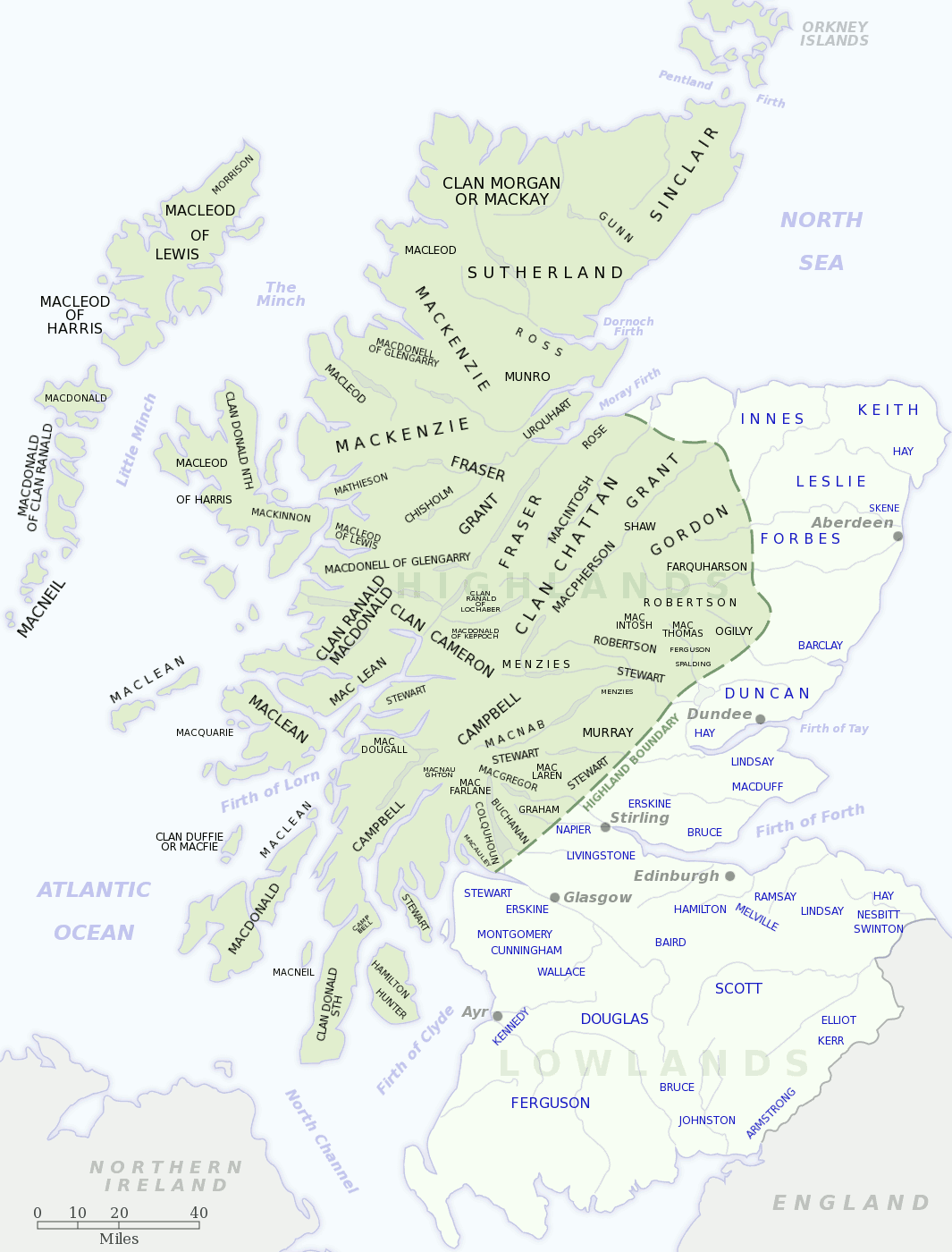| This Week’s Topic… | |

Best viewed in
|
Scottish Clans Scottish clans (from Scottish Gaelic clann, which means children, rather than "clan"), give a sense of identity and shared descent to people in Scotland and to their relations throughout the world, with a formal structure of Clan Chiefs officially registered with the court of the Lord Lyon, King of Arms which controls the heraldry and Coat of Arms. Each clan has its own tartan patterns, usually dating to the 19th century, and members of the clan may wear kilts, skirts, sashes, ties, scarves, or other items of clothing made of the appropriate tartan as a badge of membership and as a uniform where appropriate. Clans identify with geographical areas originally controlled by the Chiefs, usually with an ancestral castle or manor, and clan gatherings form a regular part of the social scene. The word clann in Gaelic means children of the family. Each clan was a large group of related people, theoretically an extended family, supposedly descended from one progenitor and all owing allegiance to the patriarchal clan chief. It also included a large group of loosely-related septs – related families - all of whom looked to the clan chief as their head and their protector. Some clans such as Clan Campbell and Clan Donald claim ancient Celtic mythological progenitors mentioned in the Fenian cycle, with a group including Clan MacSween, Clan Lamont, Clan Erinvines, Clan MacEwen, Clan MacLachlan, and MacNeil tracing their ancestry back to the 5th century High King of Ireland. Others such as Clan MacAulay, Clan MacKinnon and Clan MacGregor claim descent from the Scots King Kenneth Mac Alpin (my ancestor) who made himself King of the Picts in 843, founding the Kingdom called after the name of the land Alba (modern-day Scotland). The MacDonalds and MacDougalls claim descent from Somerled, the half-Gael/half-Norse-Manx Lord of the Isles in the mid-11th century. Though the clans had always been a feature of pre-Christian Ireland and Scotland, they first emerged into English consciousness from the turmoil of the 12th and 13th centuries when the Scottish crown pacified northern rebellions and re-conquered areas taken by the Norse, and after the fall of Macbeth when the crown became increasingly Anglo-Norman. This turmoil created opportunities for Norse, Scottish and English warlords and their kin to dominate areas, and the instability of the Wars of Scottish Independence brought in warlords with Anglo-Norman, Anglian and Flemish ancestry, founding clans such as the Camerons, Chisholms, Menzies and Grants. Successive Scottish governments had portrayed the clans as bandits needing occasional military expeditions to keep them in check and extract taxes. As Highlanders became associated with Jacobitism and rebellion the government made repeated efforts to curb the clans, culminating with brutal repression after the battle of Culloden. This followed in 1746 with the Act of Proscription, further measures making restrictions on their ability to bear arms, traditional dress, culture, and even music. The Heritable Jurisdictions Act removed the feudal authority the Clan Chieftains had once enjoyed. With the failure of Jacobitism the clan chiefs and gentry increasingly became landlords, losing the traditional obligations of clanship. They were incorporated into the British aristocracy, looking to the clan lands mainly to provide them with a suitable income. From around 1725 clansmen had been immigrating to America; both clan gentry looking to re-establish their lifestyle, or as victims of raids on the Hebrides looking for cheap labor. Increasing demand in Britain for cattle and sheep led to higher rents with surplus clan population leaving in the mass migration later known as the Highland Clearances, finally undermining the traditional clan system. Shortly before or after the Dress Act restricting kilt wearing was repealed in 1782, Highland aristocrats set up Highland Societies in Edinburgh and other centers including London and Aberdeen, landowners' clubs with aims including "Improvements" (which others would later call the Highland Clearances). Clubs like the Celtic Society of Edinburgh included Highland chieftains and Lowlanders taking an interest in the clans. The success of the historical novels of Sir Walter Scott as well as the pomp surrounding the visit of King George IV to Scotland in 1822 spurred 19th century interest in the clans and a reawakening of Scottish culture and pride.
|
